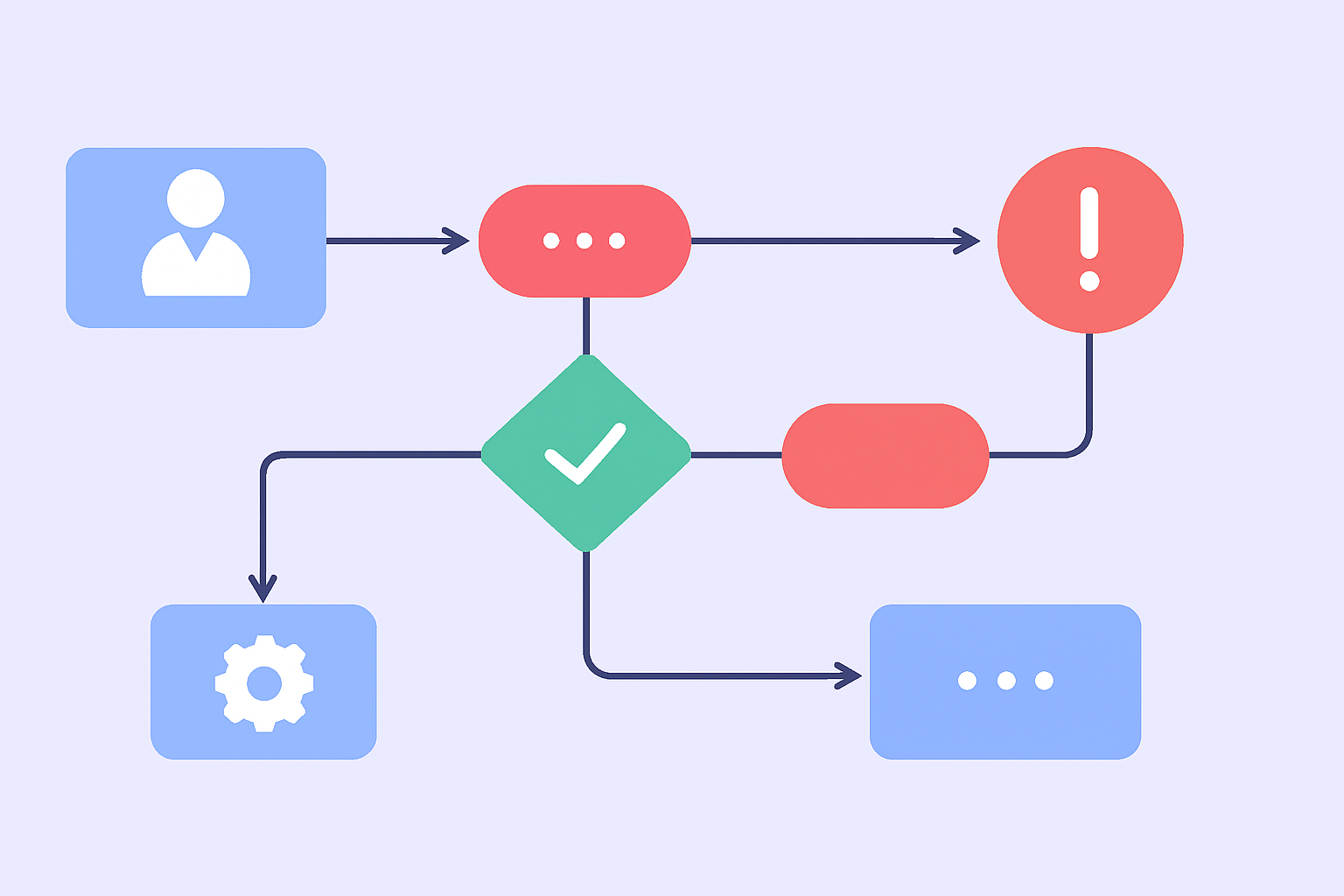Advanced n8n Workflows: Conditional Logic & Error Handling

Automation has become the backbone of modern business operations. Companies have turned to tools such as N8N, an open-cell, low-code automation platform, to eliminate repeated tasks, combine multiple applications, and create seamless workflow. While the novice-friendly interface of the N8N allows anyone to begin to create a simple automation, expertise in advanced concepts such as conditional logic and error management can enhance workflow in intelligent, self-employed systems.
This detailed summary provides a comprehensive look at how conditional logic and error management transform N8N workflow into powerful, reliable automation solutions. How these concepts work to make your work flow smarter and more elastic, divide their practical applications and best practices.
Table of Contents
Understanding Advanced n8n Workflows
At its origin, the N8N (nodmation) is built around the concept of nodes—each of the automation processes is a step. You can connect these nodes to create a workflow that interacts with an API, a database, a messaging platform, or custom systems. A simple workflowcan get information from a Google Sheet and send an email. However, as the requirements increase, you will need to make decisions to make the conditional branches and the methods of mistake to ensure reliability.
Advanced workflowsmimic human logic—determining what to do on the basis of information and automatically recovering from problems. This level of sophistication turns automation into a reliable digital assistant rather than just a steady step.
Conditional Logic in n8n
Conditional logic is the foundation of intelligent automation. It allows your workflows to make decisions dynamically, much like “if-then-else” statements in programming.
What Conditional Logic Does
Conditional logic allows N8N:
- Evaluate data from previous nodes.
- Create branches on different routes based on situations.
- Do specific actions based on variable results.
For example, workflow can do this:
- Send different responses based on the customer’s subscription level.
- Route functions in various departments based on ticket priority.
- Process the payment only if the required fields are valid.
Key Nodes for Conditional Logic
n8n provides multiple ways to implement decision-making:
1. IF node
The IF node is the most common way to add conditions. The condition is true or evaluated falsely, then directs the work flows accordingly.
Example: If the total amount of the order is more than $1000, send a Slack alert to the finance team. Otherwise, continue the process.
The IF node supports numerical, string, and Boolean comparisons, which makes it versatile for data-based automation.
2. Change the node
When multiple conditions exist, the switch node is ideal. It allows multiple cases and operates the corresponding branch.
Example: If the priority of a task is “high,” notify the manager. If it is “middle,” send a reminder email. If it is “low,” add it to the backlog.
This node facilitates workflow by avoiding multiple nested IF nodes.
3. Work node
The function node presents Javascript-based flexibility. You can write custom logic, process the array, or dynamically validate the data.
Example:
if (item.json.status === 'pending' && item.json.retries < 3) {
return [item];
} else {
return [];
}This node is powerful for users with basic coding knowledge, allowing for deep customization.
4. Merge and Split Nodes
In advanced scenarios, Merge and Split In Batches nodes combine conditional logic with parallel processing. They can merge multiple branches or process data in batches while still maintaining decision-based control.
Real-World Conditional Logic Example: Lead Management
The marketing team can use N8N to manage incoming leads:
- The webhook node receives the main information.
- The IF node checks that “Lead Source” is LinkedIn, which is a website form.
- If it’s LinkedIn, the workflow assigns it to a B2B sales representative.
- If it is from the website, it leads to a marketing automation system.
The switch checks the node “territory” and sends the lead to the relevant regional team.
By applying conditional logic, the team ensures that leads are immediately assigned and accurately assigned—responsive time and efficiency.
Error Handling in n8n
The best-made workflow may also experience errors—API timeout, invalid inputs, or network failures. Without proper management, a failed node can prevent the entire process.
There, the management of the error in the N8N becomes invaluable. It ensures that the errors are caught, logged, and resolved automatically when possible.
Common Types of Errors
- Node-layer errors: A single node fails due to bad request, timeout or configuration problem.
- Workflow-Level Mistakes: Logic or structural problems in workflow cause execution failure.
- External Mistakes: API Downtime, Finished credentials, or incorrect response from third-party services.
Each requires a different recovery approach.
Error Handling Mechanisms in n8n
n8n includes multiple strategies to manage and recover from errors effectively.
1. Global Error Workflow
The global error workflow acts as a universal catcher for all workflow failures. When any workflowsfail, this mistake can do this:
- Send notifications by email, Slack, or Teams.
- Write errors in a database or spreadsheet.
- Try failed operations again.
- Trigger warnings to DevOps or support teams.
Steps to establish:
- Create a new workflow with an error trigger node.
- Add actions such as sending a Slack message or writing to a log file.
- Mark it as a global error function in the N8N settings.
This makes the centralization easier.
2. Error trigger node
The error trigger node is specifically designed to capture and process errors from any workflow. It provides details such as:
- Working instrument
- Node name
- Error message
- Stack trace
This information helps to quickly determine the failure points.
3. Node-level error branches
Each node in N8N can have an error branch—a red attachment path that is activated when the node fails. This feature mimics the “try-catch” method from programming.
Example: If the HTTP request node for the API fails, the error branch can do this:
- Try the request again after the delay.
- Type the error details.
- Send a warning to the monitoring system.
The management of a local error easily continues the workflows without interrupting the unrelated branches.
4. Retries and Timeouts
Allows for N8N nodes to set the return limitations and custom timeouts:
- Review: Automatically repay the failed actions to a defined limit.
- Timeout: Prevent the knots from hanging indefinitely.
This ensures that the workflow does not get stuck and reduces the manual restart.
Combining Conditional Logic and Error Handling
The most powerful n8n workflows integrate conditional logic and error handling to create adaptive, self-repairing automations.
Example: Payment Processing Workflow
- Webhook Node: Receives payment data.
- IF Node: Validates payment fields.
- If valid → proceed.
- If invalid → trigger error handler and notify support.
- HTTP Node: Calls payment gateway API.
- Error Branch: If it fails, retry three times.
- Switch Node: Checks response:
- Success → send confirmation.
- Pending → schedule a retry.
- Failure → log error and alert the finance team.
This smart combination ensures that the workflow adapts dynamically to real-world issues, reducing manual oversight.
Best Practices for Building Resilient n8n Workflows
1. Keep workflow modular
Divide complex workflow into small, reusable sub-currents using an executive workflow node. This modular approach simplifies maintenance.
2. Making a mistake
Use the global error workflow for notifications and analysis, while also applying local error management for specific nodes.
3. Use descriptive names and comments
Label nodes and branches clearly. Add the annotations to the document’s terms and error recovery logic.
4. Test each branch
Use sample data to test every possible passage in your conditional logic. Silence about small wrong configurations can cause failure.
5. Implement logging and monitoring
Take advantage of execution history and log features in N8N to monitor the operation and quickly troubleshoot.
6. Automatically automate repayments
For time-sensitive workflow, try a delay or conditional recipe to prevent spamming APIs or systems.
7. Version Control
Exporting the workflow regularly and storing it in version control (e.g., GIT) allows this simple rollback and collaboration.
Real-World Application: Automated Customer Onboarding
Let’s see how conditional logic and error handling combine in a real scenario.
Workflow Steps:
- Trigger: A customer signs up via a form.
- Validation: IF Node ensures all required fields (email, plan type) are present.
- Conditional Routing:
- If “Plan = Enterprise,” assign an account manager.
- If “Plan = Basic,” trigger a standard onboarding sequence.
- Error Handling:
- If CRM integration fails, retry and notify the support team.
- Log all errors in Google Sheets.
- Completion: Send a personalized welcome email.
Result:
- No lead is lost due to technical errors.
- Each customer gets a tailored onboarding experience.
- Teams are alerted instantly when something goes wrong.
Benefits of Advanced Workflow Design
By integrating conditional logic and error handling, n8n users gain:
- Higher Reliability: Automatic recovery from errors minimizes downtime.
- Dynamic Decision-Making: Workflows adapt to real-time data conditions.
- Scalability: Modular, fault-tolerant designs can handle large data volumes.
- Reduced Manual Oversight: Automated alerts and retries free up human resources.
- Better Data Integrity: Ensures clean, accurate, and traceable process flows.
Key Takeaway:
Creating advanced workflows in N8N using conditional logic and error management is the key to strong, intelligent automation. These features allow your workflowsto be considered, make a decision, and recover by maintaining a human decision by maintaining the precision of the machine.
Conditional logic gives the workflow adaptability—determining what to do based on data reference—when the management of the error is stable, ensuring to capture and resolve issues without manual input. Together, they create elastic automation capable of working reliably in a complex, rapidly changing environment.
Authorizing CRM operations, payment systems, or data pipelines, understanding these advanced techniques converts the N8N to the correct process orchestration powerhouse.
As you improve your N8N skills, do not focus only on what your workmen can do but on how they react when things do not run as planned. There is real intelligence in automation.

